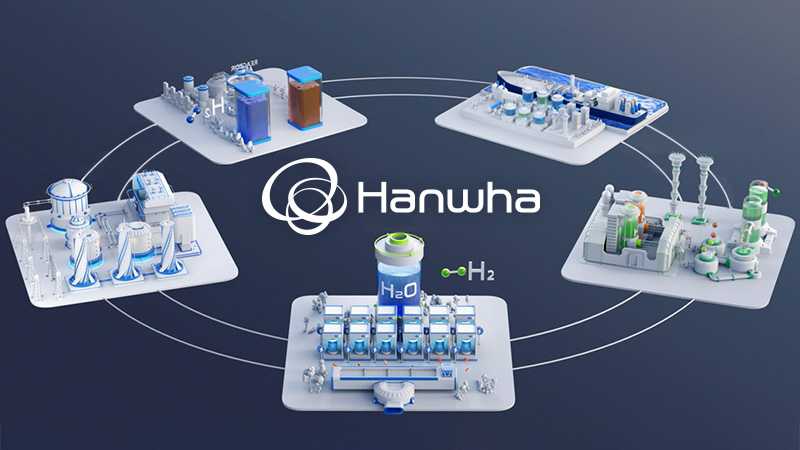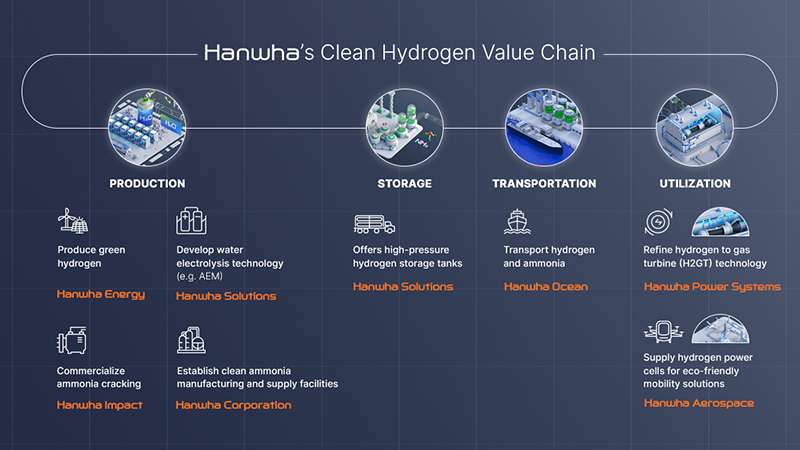Hanwha Affiliates Leverage Capacity to Establish a Clean Hydrogen Value Chain

- Hanwha will establish a clean hydrogen value chain encompassing hydrogen production, storage, transportation, and utilization through cooperation among seven of its affiliates.
- Hanwha’s clean hydrogen business will join its existing green energy businesses in contributing to global carbon neutrality efforts.
Hanwha showcased the future of hydrogen, emphasizing the potential creation of a comprehensive clean hydrogen value chain through collaboration with seven of its affiliates. The involved entities are Hanwha Corporation, Hanwha Energy, Hanwha Solutions, Hanwha Aerospace, Hanwha Ocean, Hanwha Impact, and Hanwha Power Systems. The presentation took place at H2MEET 2023, an international hydrogen industry exhibition held in South Korea.
Hanwha’s hydrogen value chain will use renewable energy and ammonia and encompass clean hydrogen production, storage, transport, and utilization. The company’s burgeoning clean hydrogen business will join its existing eco-friendly energy portfolio to further its contribution to global carbon neutrality efforts.
In order to further develop clean hydrogen production technology, Hanwha Solutions is developing next-generation anion exchange membrane water electrolysis (AEMWE)¹ technology, which can produce hydrogen using less power and with a lower initial investment cost than existing water electrolysis methods. Electrolysis can be powered using renewable energy sources like wind and solar power to produce green hydrogen. Hanwha Energy also plans to contribute to the supply of green hydrogen in the U.S. through renewable energy sources.

Through the creation of a single hydrogen value chain, Hanwha will be able to seamlessly manage its clean hydrogen operations from end to end
Hanwha Corporation plans to establish competitive ammonia manufacturing and supply facilities both domestically and globally through cooperation with businesses in North America, Australia, and the Middle East. As it can store hydrogen at high volumes, ammonia is being recognized as a promising carrier within the expanding hydrogen economy. Hanwha Impact is also conducting R&D and working with diverse partners in service of its goal of commercializing ammonia cracking² by 2027.
Hanwha Solutions offers a range of hydrogen storage solutions, including composite high-pressure tanks optimized for a variety of uses and methods of transportation including trailers, hydrogen vehicles, drones, and aerospace vehicles. Hanwha Cimarron, a subsidiary of Hanwha Solutions, has joined hands with Shell to build extensive hydrogen refueling infrastructure in California by supplying its Neptune 517-bar hydrogen tanks, the highest among Type IV tanks.
Hanwha Ocean will also play a key role in the transportation of hydrogen with its hydrogen and ammonia carriers and green ships³ that run on an eco-friendly propulsion system based on ammonia, methanol, and hydrogen. The company has earned Approval in Principle (AiP) from the British Lloyd's Register classification society and the American Bureau of Shipping (ABS) for its ammonia-propelled carriers.
Hanwha Power Systems continues to refine its hydrogen co-firing technology, or hydrogen to gas turbine (H2GT) technology — an intermediary technology crucial in realizing 100 percent hydrogen power generation. Alongside its partners Thomassen Energy in the Netherlands and Power Systems Mfg. (PSM) in the U.S., Hanwha has been working to advance hydrogen co-firing gas turbine solutions, which recently led to the world’s first 60 percent hydrogen co-firing of an 80-megawatt gas turbine.
Hanwha’s hydrogen value chain extends to power cells for use in eco-friendly mobility technology and transportation. Hanwha Ocean has equipped 3,000-ton submarines with its hydrogen fuel cell systems, and Hanwha Aerospace plans to utilize 100 kW lightweight hydrogen fuel cells in urban air mobility (UAM) and regional air mobility (RAM) as part of its aim to expand its eco-friendly air mobility business.
| ¹ Anion exchange membrane water electrolysis (AEMWE): A potentially low-cost and sustainable technology for hydrogen production that combines the advantages of proton exchange membrane water electrolysis and traditional alkaline water electrolysis systems. ² Ammonia cracking: A process of producing hydrogen from ammonia decomposition over a catalyst at high temperatures. ³ Green ships: Eco-friendly vessels outfitted with energy efficient, green technologies aimed at suppressing greenhouse gas emissions and meeting IMO emissions standards. |

